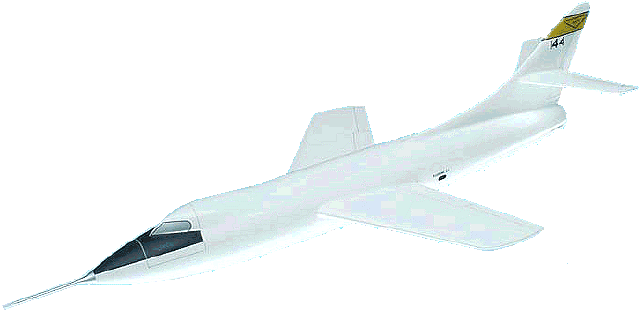|
|
| Douglas
D-558-2 Skyrocket |
 |
 |
On November 20, 1953, the Douglas D-558-2 Skyrocket became the first
aircraft to fly faster than Mach 2, twice the speed of sound. Piloted by
A. Scott Crossfield, it was air-launched from a U.S. Navy Boeing P2B-1S
(B-29) the swept-wing, rocket-powered D-558-2 reached Mach 2.005 in a
shallow dive at 18,898 meters (62,000 feet). This swept wing
research plane attained Mach 2.005 (1,291 mph) while in a shallow dive at
an altitude of 62,000 feet. Seconds afterward, the plane’s XLR-8 rocket
engine exhausted its fuel supply and shut down. Crossfield glided
earthward to a smooth dead-stick landing on Muroc Dry Lake, at Edwards Air
Force Base, California.
D-558-2 #2 was just one of six different D558
research airplanes ordered by the U.S. Navy from the Douglas Aircraft
Company for obtaining aerodynamic information at transonic and supersonic
speeds. The Navy issued a letter of intent to Douglas on June 22, 1945,
for construction of six Model D-558 aircraft, having straight, thin wing
and tail surfaces, and turbojet propulsion.
The D-558-1 and D-558-2 greatly differed from one
another in detail design and there was little commonality between them.
Both took off from the ground. Because of its engine type and airframe
design, the D-558-1 was limited to approximately Mach 1, the speed of
sound. The more powerful D558-2, using its 6,000-pound-thrust rocket
engine fueled with liquid oxygen and diluted ethyl alcohol, could easily
exceed Mach 1. The safety hazards of operating a heavily loaded
rocket-propelled airplane from the ground later caused Douglas to modify
the D-558-2 #2 and #3 for air launching from the bomb bay of a converted
Boeing P2B-1S (Navy B-29) Superfortress. At the same time, Douglas
modified the D-558-2 #2 to all-rocket propulsion, utilizing the space
formerly taken up by its turbojet engine for additional rocket fuel. Thus
modified, the D-558-2 #2 was capable of reaching Mach 2, which it did
while being flown in a special high-speed flight research program by the
National Advisory Committee for Aeronautics (NACA).
The D-558-1 and D-558-2 were of mixed aluminum and
magnesium construction. Both types featured jettisonable nose sections to
serve as emergency escape capsules. and both were designed to carry heavy
instrumentation payloads for flight research purposes. The first two
D-558-1 Skystreaks were bright glossy red overall, but the D-558-1 #3 and
later D-558-2 Skyrockets were glossy white, which proved more desirable
for optical tracking purposes. The historic Douglas D558-2 #2, NACA 144,
the first Mach 2 airplane, is in the collection of the National Air and
Space Museum. |
| |
|
